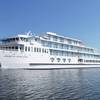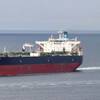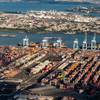With a history spanning three generations and more than 80 years, Bender Shipbuilding & Repair Co., Inc. is quite the familiar face in the Gulf Coast marketplace. Tracing origins back to 1919, when Theodore Jackson (T.J.) Bender, armed with knowledge from his apprenticeship at Ollinger Iron Works, formed Bender Welding and Machine Company; Bender Shipbuilding has adjusted and changed to market demand, building an assortment of vessels - ranging from barges and pushboats to towboats and shrimp vessels to OSVs and U.S. Navy Ships, and pretty much everything in between.
T.J. Bender didn't survive to see the yard's transformation from machine ship to boatbuilder, as the company founder passed away in 1948. But his son, Thomas Benton Bender, Sr., aggressively led the company through the change, and his son, Thomas Benton Bender, Jr., has continued the company's success.
The company operated nearly exclusively as a welding and machine shop thorough the early 1950s, with certain accomplishments standing out - namely, its first big job: fabricating and erecting Mobile's Ernest M. Ladd Memorial Stadium, in the same year T.J. Bender died. Through the 1940s, the company began doing more and more topside outfitting work.
In 1950, the company supported the expansion of the Intracoastal Waterway System by building 1,200 buoys. In 1951, the company supported the Korean War effort by reactivating ships pulled from the reserve fleet.
In 1952, the company moved to the Mobile River, acquiring a piece of land that - to this day - is still the company's "Yard 1" (up until then, repairs had been done mainly at the city or state pier). The pierside repair facility included some launching ways and a covered fabrication shed. And shortly after the move, the company's first new construction vessel, a deck barge (oyster shell), was delivered to Radcliff Materials.
One year later, the company leased a 1,000 ton drydock from the U.S. Navy, and became a full-service shipyard, although merely a far smaller version of the yard it would eventually become.
A Time For Change
By the 1960s, Bender began to exhibit some signs of the wide range of projects it would someday undertake. In 1964, the company built the first in a series of 11 OSVs. In 1965, the company delivered a shrimp boat to Ken Seaman, of Bayou La Batre, which would prove to be the first of more than 1,000 fishing vessel deliveries from Bender.
Fishing vessels would be the company's staple through the early 1970s, as Bender rode the wave of industry demand, something it would do again and again, and would ultimately prove quite adept at doing. In 1971, the company began series production of standard shrimp boats for Korea and Japan. A total of 104 shrimp boats were built for operation in South America.
In 1972, the company received an order for 50 72 ft. shrimp boats - the largest fleet order for steel fishing vessels in U.S. history. At the peak of construction, Bender was delivering a vessel a week to the customer, KMIDC of Korea.
Through the 1970s, Bender continued its emergence as a premier construction and conversion yard, producing 50 98 ft. crab boats and 107, 127 and 130 ft. crab boats for the Pacific Northwest. Crab/processing vessels and stern factory trawlers ranging from 150 to 310 ft. were also built and converted.
In 1975, Thomas B. Bender, Jr. was elected president of Bender, and in 1980, one year after his father's death, the company was renamed Bender Shipbuilding & Repair Co., Inc. In 60 years, the company had transformed itself from a welding and machine shop to one of the most notable builders and repairers nationwide.
Current Day
Twenty years after renaming itself, Bender Shipbuilding & Repair is one of the premier facilities along the Gulf Coast. The company's repair division includes four docks: one Panamax dock with a 24,000 ton lifting capacity, and three smaller docks with 18,000 ton, 5,000 ton and 3,000 ton lifting capacities. Ther are also extensive pierside facilities for topside repairs, says Frank Terrell, vice-president, sales and marketing.
Terrell says the current breakdown of new construction versus repair and conversion work is approximately a 60/40 split, in the favor of repair and conversion, although, he says the company hopes to see a 50/50 split in the near future.
"As far as new construction goes, we've been adept at meeting market requirements," Terrell says. "We've always carried a good load of engineering and naval architect talent. When we see one area of construction tailing off, we concentrate on another. We keep a core of 650 people, although we have pushed up to more than 1,000 when we have a big load of boats.
"Our employees all have strengths and weaknesses - some are better at some crafts than others. But, we do stress a multi-crafting approach, and we've been fortunate through the years - when new construction is limited - that we can move our employees into ship repair work."
Company Orderbook
Bender Shipbuilding & Repair constructs, converts and repairs a wide range of vessels. Just recently, the company finished the construction of its last contracted platform supply vessel for Otto Candies, which was 20 ft. longer than the four previous covered under the contract. The same design was also recently delivered to Tidewater and Gulfmark Offshore, which received two vessels.
Currently under construction for Otto Candies are three 150 x 48 x 21, 10,000 hp triple-screw anchor handling tugs.
"These are the first tugs we've built in about 15 years," says Terrell. "Basically, Otto Candies has always been happy with our OSVs, so he approached us about the tug contract. He priced around the industry, and ultimately, we won the contract."
Otto Candies already has two triple-screw vessels, which feature two outboard propulsion systems, azimuthing z-drives and a center engine, with a conventional engine, reduction gear, shaft and propeller in a Kort nozzle; but those vessels only generate 6,000 hp. These new vessels built by Bender will feature 10,000 hp capacities. The first vessel is due during the first week of June, and subsequent vessels will follow every two to three months.
"These are pretty unique vessels," says Terrell. "They're versatile and maneuverable. Candies does a lot of barge handling for pipelay work - putting barges up against pipelay vessels. And the higher bollard pull will enhance the tug's ability to put rigs and anchors on location. While the vessel could perform an escort mission, it's primary duties will be in anchor handling and towing."
The contract - which calls for three vessels, with options for five additional vessels - is not the first tug contract Bender has bid on, although, Terrell says, they haven't bid seriously on any tug contracts recently. Now, he says, the company has two or three different prospects they're bidding seriously on.
Other ongoing constuction includes project Roy M. Wheat, for the Military Sealift Command. This project - the conversion of a 750 ft. twin-screw RoRo vessel into a marine pre-positioning force ship - entailed adding 120 ft. to the mid-body of the ship. The $130 million project was performed in conjunction with affiliated shipyard Tampa Bay Shipbuilding, of which Tom Bender Jr. owns 50 percent.
"We subcontracted the mid-body construction to Brown and Root," says Terrell. "Then we towed it down to Tampa. We brought the ship to Tampa, cut it in half, floated the fore-body out, the mid-body in, then welded the fore-body back. We should be getting the ship back in early march, at which point there'll be another year worth of construction."
Ongoing repair work for Bender includes a $3.9 million general overhaul and refurbishment project for U.S. Navy frigate Groves, as well as drydocking and general overhaul and repair work on a tug-and-barge unit from Gulf Coast Transit and a tug-and-barge unit from Crowley.
"A lot of our new construction the past three years has been oilfield-related," says Terrell. "We're cautiously optimistic regarding the future in that marketplace. We also anticipate being on the bidders list for the Tidewater new-build program. We've got some projects in the planning that aren't oilfield construction-related.
"We made a decision three or four years ago to diversify our interests. We think we were right. The oilfield industry is too volatile to put all your eggs in that one basket."
Outlook for the Future
"Since we've always stressed multi-crafting, we have an ongoing training program to enable employees to become Master Craftsmen. It's a voluntary program of not cost to the employee. In fact, 40 percent of our workers are master craftsmen, and they're all graduates of that voluntary program.
"Keep a man satisfied that he's challenged, then compensate him monetarily - that works out to be a good morale booster."
The company also runs a safety program, with a volunteer-staffed safety committee, which meets every two weeks to review accidents and violations. The committee issues recommendations and forms solutions, and also awards safety awards and incentives for keeping the shipyard safe.
"In the past four or five years, we've taken advantage of the MARITECH programs," says Terrell. "We've partnered with Caterpillar and other entities to improve our manufacturing processes and facilities improvement. We did a technology-sharing program with Germany shipbuilder Flensberger Shipyard, in Flensberg."
German shipyards, with expensive manhours, says Terrell, were forced to develop systems to better utilize manhours. As such, there is a high degree of sophistication in scheduling and planning, including a concept called "level-loading," in which the manufacturing process does not entail peaks and valleys in manpower. Rather, the concept calls for workstations where there are specific amounts of men doing basically the same amount of work throughout the construction process.
"Although level-loading isn't a new concept - the Japanese started using it years ago - Flensberger has roughly the same sized yard and the same number of employees, so the process transferred well to us," says Terrell.
Bender began on its ship repair side first, changing the very way jobs were handled.
"Initially we'd get a spec in, we'd price it through estimating and we'd get the job," says Terrell. "Then, the spec would get thrown over the wall to production about two days before the ship arrived. Now, production is involved in ship-checking from the beginning, they work jointly with estimating.
"A lot of the processes put in place basically only consisted of writing down, 'this is what you do.' It seems simplistic, you ask, 'why doesn't someone automatically know to do this?' But these processes are geared to improve communication, and that starts with writing it down."
On the new construction side, Terrell says, the old methodology consisted of going into one yard and cutting steel, then, 10 months later, the boat would be built in that yard. Everything from the prefabrication of pipe, to platen work to the final outfitting of the vessel would all occur in that one yard.
Now, using a level-loaded process (see Figure 1), the process requires less manhours, and results in a more efficient, increased productivity. The process originates in the company's First Operations Shop, which consists of two 75 x 330 ft. bays, one for storage and one for production. A third bay, measuring 50 x 150 ft., houses the stiffener operation. Plate cutting and forming, and ultimately stiffener cutting are all performed in the shop, and then the material is moved. In all, nearly 10 different areas are utilized to construct the vessel; with many of the areas working simultaneously.
"That's truly the secret to making money: If you can handle a piece of material just once, that's enough. The more times you handle a piece of material, the more expensive it becomes."
Subscribe for
Maritime Reporter E-News
Maritime Reporter E-News is the maritime industry's largest circulation and most authoritative ENews Service, delivered to your Email five times per week












